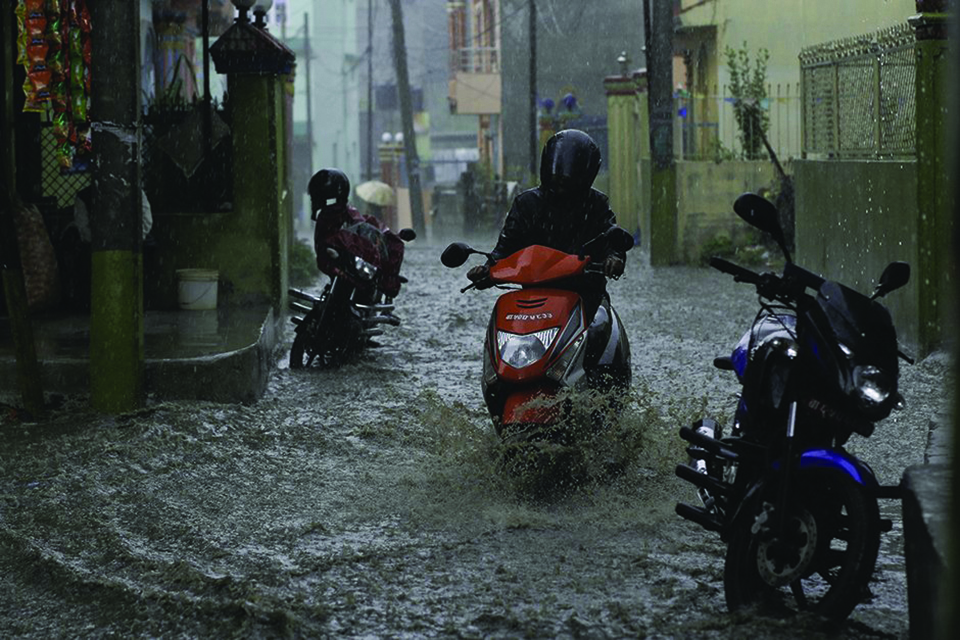
June 11, 2019 Kripendra Amatya : The houses and structures which have blocked rajkulos and canals should be shifted elsewhere
With the onset of monsoon, pictures of Kathmandu streets being waterlogged have started to surface in social media. Royal canals, called rajkulo, are blocked by infrastructures. Concrete building and blacktopped roads stop infiltration of rain in soil, causing the ponds to go dry. As water fails to enter the soil due to concrete houses and paved roads and the sewerage gets jammed due to litter, even light rains could cause spread of water on the streets in the capital city. And as the water cannot enter the soil, underground water level decreases every year and people are forced to dig deeper to extract the underground water.
Kathmandu is already suffering from water deficit of 102 million liters per day (MLD). Ultimate capacity of Melamchi Water Project is estimated to be 510 MLD and it is expected that there won’t be water deficit till 2023-2025. But this estimation does not take into consideration the rapid rise of urbanization around the Valley. The current demand of Kathmandu is already 360 MLD but if the urbanization continues unabated, Melamchi Project won’t be able to meet the water needs of all households. Thanks to the remaining farms around Kathmandu Valley, which allow the water to enter the soil and maintain a level of groundwater. But if these farms are also concretized, the groundwater will dry up much faster, forcing people to solely depend on scarce tap water.
When the outer ring road is built, it would obstruct seepage of water under the soil, again contributing to reducing level of underground water. With outer ring road, there will also be rise in land plotting and land selling for building purpose, which will again raise the demand for drinking water. Naturally, people love to live in urban spaces. We cannot stop them from coming to Kathmandu. Thus the government needs to allocate new spaces for urban infrastructure around the potential routes in much wider area covering multiple districts connected to Kathmandu. These lands would be obviously cheaper than lands inside the Valley. It would also stop further concretization of the Valley.
People living in Kathmandu Valley have little interest in agriculture. The government in partnership with local citizens and agriculture-based international companies can introduce urban agriculture program. The products can be easily consumed by local markets of Kathmandu where there is never-ending demand for vegetables and meat. It is important for Nepal to produce essential food items within the country because it is vulnerable to external shocks like blockade. The houses and structures which have blocked rajkulos and canals should be shifted elsewhere so that water can fill these ponds and recharge ground-level water. In addition, the government should encourage rainwater harvesting and culture of building reservoirs for long term use.
Many of the ponds have been usurped illegally and in their places houses have been built. In such circumstances, it may not be fair to simply destroy these houses. If such lands are found to be illegal but of higher value, the government should evaluate life of buildings and allow owners to use these houses for certain years on lease. Such efforts would create a win-win situation. Even though such lands were acquired illegally and should not be rewarded for the crimes they have committed, it may be a necessary step in order to avoid the possible conflict. We need to keep the agricultural spaces nearby the city because in case of earthquakes, people will need new spaces to live in. Besides, while constructing anything in Kathmandu, we need to ensure that groundwater level does not go down. Most of all, development should not be limited within the spaces of Kathmandu Valley. It should be taken beyond the valley in other parts of the country as well. The author is a core member of Save Nepa Valley Movement, a network fighting against illegal road expansion and destruction of life and heritage in Kathmandu Valley. Views are personal
Source: My Republica

